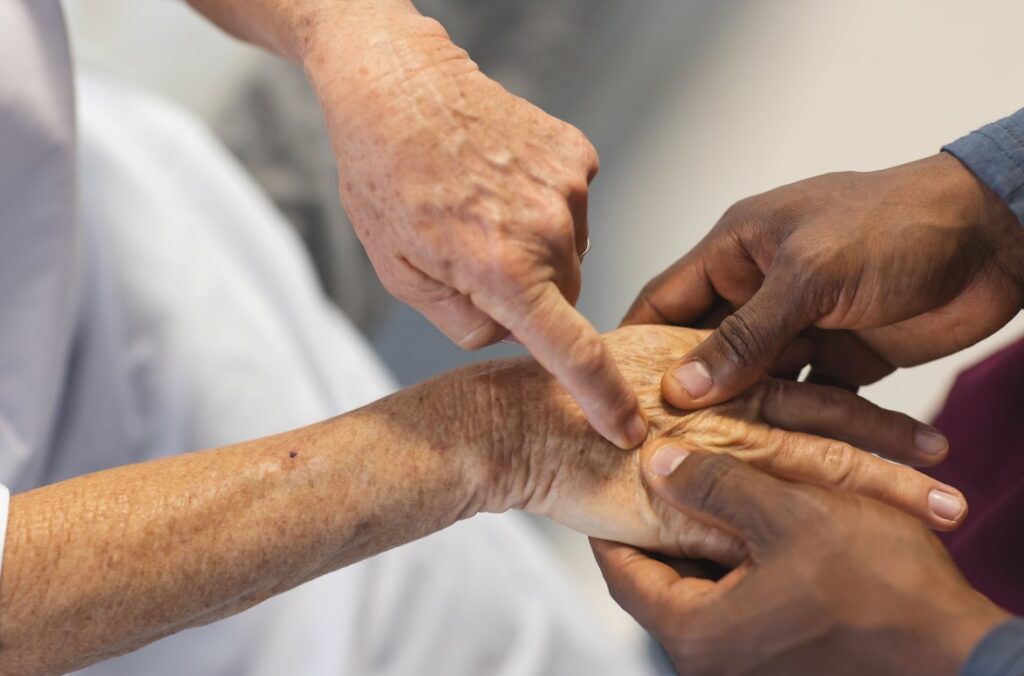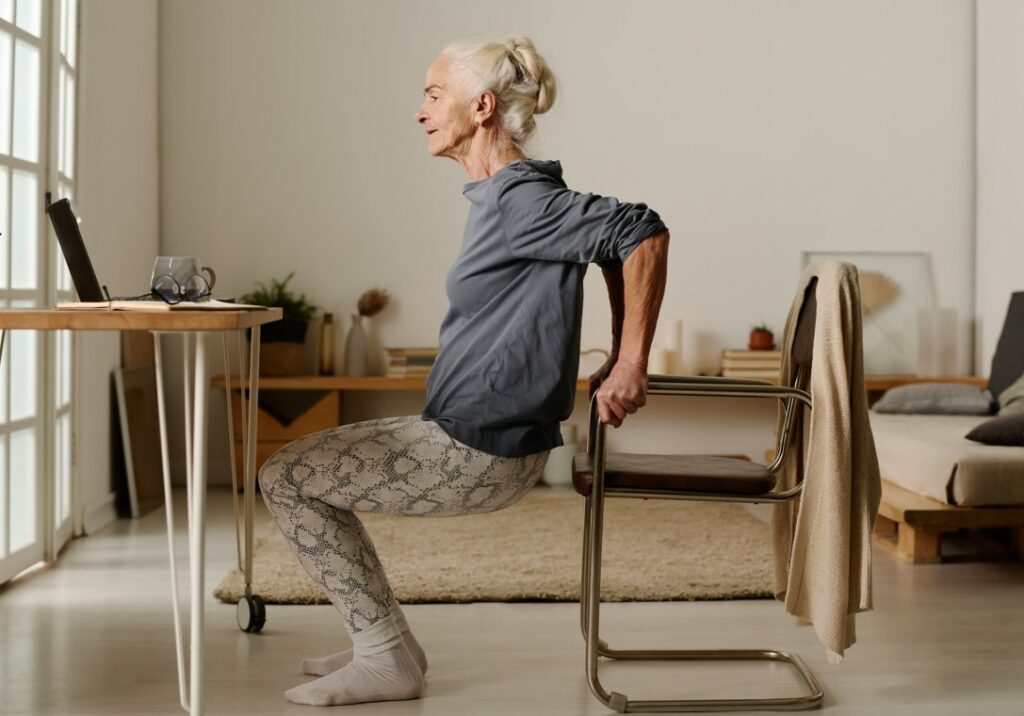As our population ages, the significance of promoting health and well-being among seniors, particularly those with restricted mobility, becomes increasingly evident. The pursuit of an active lifestyle is not only about physical fitness but also about fostering a sense of vitality and independence in later years.
In this exploration, we delve into the realm of safe and accessible exercises tailored specifically for seniors facing challenges in mobility. Recognizing the unique needs of this demographic, we aim to shed light on exercise routines that not only prioritize safety but also cater to varying levels of mobility limitations.
Choosing Exercises for Seniors with Limited Mobility: A Comprehensive Guide
- Understanding Unique Considerations:
Seniors with limited mobility often face distinct challenges, such as joint stiffness, reduced flexibility, and potential balance issues. Tailoring exercise routines to address these specific considerations is fundamental for a safe and effective fitness program.
- Joint Health: Prioritize exercises that promote joint mobility without causing strain. Low-impact activities like swimming or stationary biking can be excellent choices.
- Flexibility: Include stretches that enhance flexibility, focusing on major muscle groups. Gentle yoga or modified stretching routines can contribute to improved range of motion.
- Balance and Stability: Incorporate exercises that strengthen core muscles to enhance balance and stability. Simple leg lifts or seated core exercises can be beneficial.
- Safety First:
Safety is paramount when developing exercise programs for seniors. Paying close attention to potential risks and ensuring a secure environment is crucial.
- Low-Impact Options: Opt for low-impact exercises to minimize stress on joints and reduce the risk of injuries. Walking, water aerobics, or chair exercises are excellent choices.
- Proper Equipment: Ensure that any exercise equipment is user-friendly and adapted to the individual’s needs. This may include stable chairs, non-slip mats, or assistive devices.
- Adaptability for Varied Mobility Levels:
Recognizing the diverse range of mobility limitations among seniors, the exercise program should be adaptable to accommodate different levels of capability.
- Progressive Challenges: Offer exercises with varying difficulty levels, allowing seniors to progress at their own pace. Gradual increases in intensity ensure a safe and sustainable fitness journey.
- Customized Modifications: Provide modifications for each exercise to accommodate different mobility levels. This may involve seated variations or using additional support when needed.
- Consultation and Professional Guidance:
Before initiating any exercise program, it is essential for seniors to consult with healthcare professionals. A medical assessment can help identify specific needs and tailor the exercise routine accordingly.
- Medical Clearance: Obtain clearance from a healthcare provider to ensure that chosen exercises align with the individual’s health status and any existing medical conditions.
- Physical Therapist Collaboration: Consider involving a physical therapist in the planning process. Their expertise can contribute to creating a personalized program that addresses specific mobility challenges.
By integrating these considerations into the selection of exercises, you can create a well-rounded and safe fitness routine for seniors with limited mobility. This guide serves as a roadmap to empower seniors on their journey to improved health and well-being.

Low-Impact and Mobility-Friendly Exercises:
When designing an exercise regimen for seniors with limited mobility, incorporating low-impact and mobility-friendly exercises is crucial for promoting both safety and effectiveness. These exercises aim to minimize stress on joints while enhancing overall mobility. Below are key considerations and examples for integrating low-impact and mobility-friendly activities into a senior fitness routine:
- Benefits of Low-Impact Exercises:
Low-impact exercises offer a gentler alternative to traditional high-impact activities. These activities provide numerous benefits, including reduced risk of injury, improved joint health, and increased cardiovascular endurance.
- Joint Health: Activities like walking, swimming, and stationary biking are gentle on joints, making them ideal for seniors with mobility challenges.
- Cardiovascular Health: Low-impact aerobic exercises contribute to cardiovascular health without placing excessive strain on the heart and joints.
- Walking and Modified Cardio Workouts:
- Walking Programs: Encourage regular walking, either outdoors or on a treadmill, as a fundamental low-impact exercise. Consider incorporating walking groups for added social interaction.
- Seated Cardio Workouts: For those with limited mobility, seated exercises such as marching in place or seated leg lifts can provide cardiovascular benefits without putting stress on the joints.
- Swimming and Water Aerobics:
- Swimming: The buoyancy of water reduces impact on joints, making swimming an excellent full-body workout. Swimming laps or participating in water aerobics classes can enhance strength and endurance.
- Water Aerobics: Conducting exercises in a pool environment adds resistance, promoting muscle engagement while minimizing stress on joints.
- Chair Exercises for Strength and Flexibility:
- Seated Strength Training: Utilize resistance bands or light weights for seated strength exercises. This can target various muscle groups while providing stability.
- Chair Yoga: Incorporate gentle yoga stretches and poses that can be modified for seated positions, focusing on improving flexibility and balance.
- Adaptability and Personalization:
- Customized Modifications: Tailor exercises to individual needs and mobility levels. Provide variations for each exercise, ensuring that participants can progress at their own pace.
- Individualized Plans: Consider creating personalized exercise plans based on the specific mobility challenges of each individual, incorporating a mix of low-impact activities that align with their capabilities.

Strength and Flexibility Training for Older Adults: A Holistic Approach to Health
As individuals age, maintaining muscle strength and flexibility becomes increasingly vital for overall well-being. This section focuses on the significance of incorporating strength and flexibility training into the exercise routine for older adults, emphasizing not only physical benefits but also the positive impact on cognitive health.
- The Importance of Muscle Strength and Flexibility:
Maintaining muscle strength and flexibility is essential for seniors to preserve mobility, independence, and overall functionality. These factors contribute significantly to a higher quality of life as individuals navigate their golden years.
- Independence: Strong muscles and flexible joints support daily activities, promoting independence in tasks like walking, reaching, and bending.
- Joint Health: Regular strength and flexibility training help in preventing joint stiffness and reducing the risk of musculoskeletal issues.
- Cognitive Benefits of Physical Exercise:
It’s crucial to recognize that strength and flexibility training extend beyond physical health; they play a pivotal role in cognitive well-being.
- Memory and Cognitive Function: Studies have shown that engaging in regular physical activity, including strength training, can positively impact cognitive function. This includes improvements in memory, attention, and overall mental acuity.
- Mood Enhancement: Exercise releases endorphins, promoting a positive mood and reducing the risk of cognitive decline associated with aging.
- Resistance Exercises for Strength:
- Bodyweight Exercises: Encourage exercises that utilize one’s body weight, such as squats, lunges, and push-ups, to build and maintain muscle strength.
- Resistance Bands: Incorporate resistance bands for gentle yet effective resistance training. These are adaptable to various fitness levels and can target specific muscle groups.
- Suitable Stretching Routines for Flexibility:
- Dynamic Stretching: Begin sessions with dynamic stretches to warm up muscles and increase flexibility. Arm circles, leg swings, and gentle torso twists are excellent examples.
- Static Stretching: Include static stretches at the end of the workout to improve overall flexibility. Focus on major muscle groups, holding each stretch for a duration that allows for a comfortable stretch.
- Incorporating Mind-Body Connection:
Recognize the interplay between physical and mental well-being. Combining strength and flexibility training with mindfulness exercises, such as yoga or tai chi, enhances the mind-body connection.
- Mindful Movements: Activities like yoga promote relaxation and mindfulness, fostering a holistic approach to health that benefits both the body and the mind.

Safety Tips and Medical Consultation: Ensuring a Secure and Healthy Fitness Journey
Ensuring the safety of older adults during physical activity is paramount for a positive and sustainable fitness journey.
- General Safety Guidelines:
Implementing general safety measures is crucial to creating a secure environment for older adults engaging in physical activity.
- Warm-Up and Cool Down: Prioritize incorporating warm-up and cool-down routines to prepare the body for exercise and aid in recovery, reducing the risk of injuries.
- Proper Footwear: Advise participants to wear supportive and comfortable footwear to enhance stability and reduce the risk of slips or falls.
- Hydration: Emphasize the importance of staying hydrated, as older adults may be more susceptible to dehydration. Encourage regular water intake throughout the exercise session.
- Adaptation and Modification:
Individualized Modifications: Recognize that each individual has unique needs and capabilities. Encourage participants to modify exercises as needed and progress at their own pace. This can involve adjusting intensity, range of motion, or incorporating additional support.
Listening to the Body: Stress the significance of listening to one’s body. Participants should be aware of any discomfort, pain, or unusual sensations during exercise and modify or stop activities accordingly.
Professional Supervision: If possible, consider organizing sessions with the supervision of fitness professionals or trainers experienced in working with older adults. Their guidance can ensure exercises are performed safely and effectively.
- Importance of Medical Consultation:
Underscore the crucial step of consulting with a healthcare professional before initiating any new exercise program, especially for older adults.
- Health Assessment: Stress the importance of a thorough health assessment by a qualified healthcare provider. This assessment should consider existing medical conditions, medications, and any potential contraindications to certain exercises.
- Individualized Exercise Recommendations: A healthcare professional can provide personalized exercise recommendations based on an individual’s health status, ensuring that the chosen activities align with their capabilities and goals.
- Monitoring Chronic Conditions: For individuals with chronic conditions, such as heart disease or diabetes, regular medical check-ups are essential to monitor progress and adjust exercise routines accordingly.
As we wrap up our exploration of safe and accessible exercises for seniors with restricted mobility, it’s important to acknowledge the multifaceted challenges and considerations involved in promoting well-being in this demographic.
This comprehensive guide endeavors to shed light on tailored exercise routines, prioritizing safety and adaptability. While it provides a structured approach, it’s crucial to recognize the varied nature of individual experiences and health conditions among seniors.
The outlined considerations, from low-impact exercises to strength and flexibility training, are presented as potential avenues for exploration. However, the effectiveness and suitability of these recommendations can significantly depend on an individual’s unique circumstances. It’s essential for seniors and their healthcare professionals to collaboratively assess and decide on an approach that aligns with their specific needs.
While the guide emphasizes the importance of medical consultation, it’s imperative to acknowledge that healthcare decisions are nuanced and should be made in consultation with qualified professionals. The guide acts as a resource, but the responsibility lies with individuals and their healthcare providers to make informed decisions based on personal health status, preferences, and medical advice.
In conclusion, the journey toward senior fitness is diverse, and this guide is just one perspective. Seniors are encouraged to approach their fitness endeavors with a critical eye, seeking personalized advice and making choices that resonate with their unique circumstances. The goal is not only to exercise safely but to cultivate a sustainable and enjoyable approach to health and well-being in the later stages of life.










